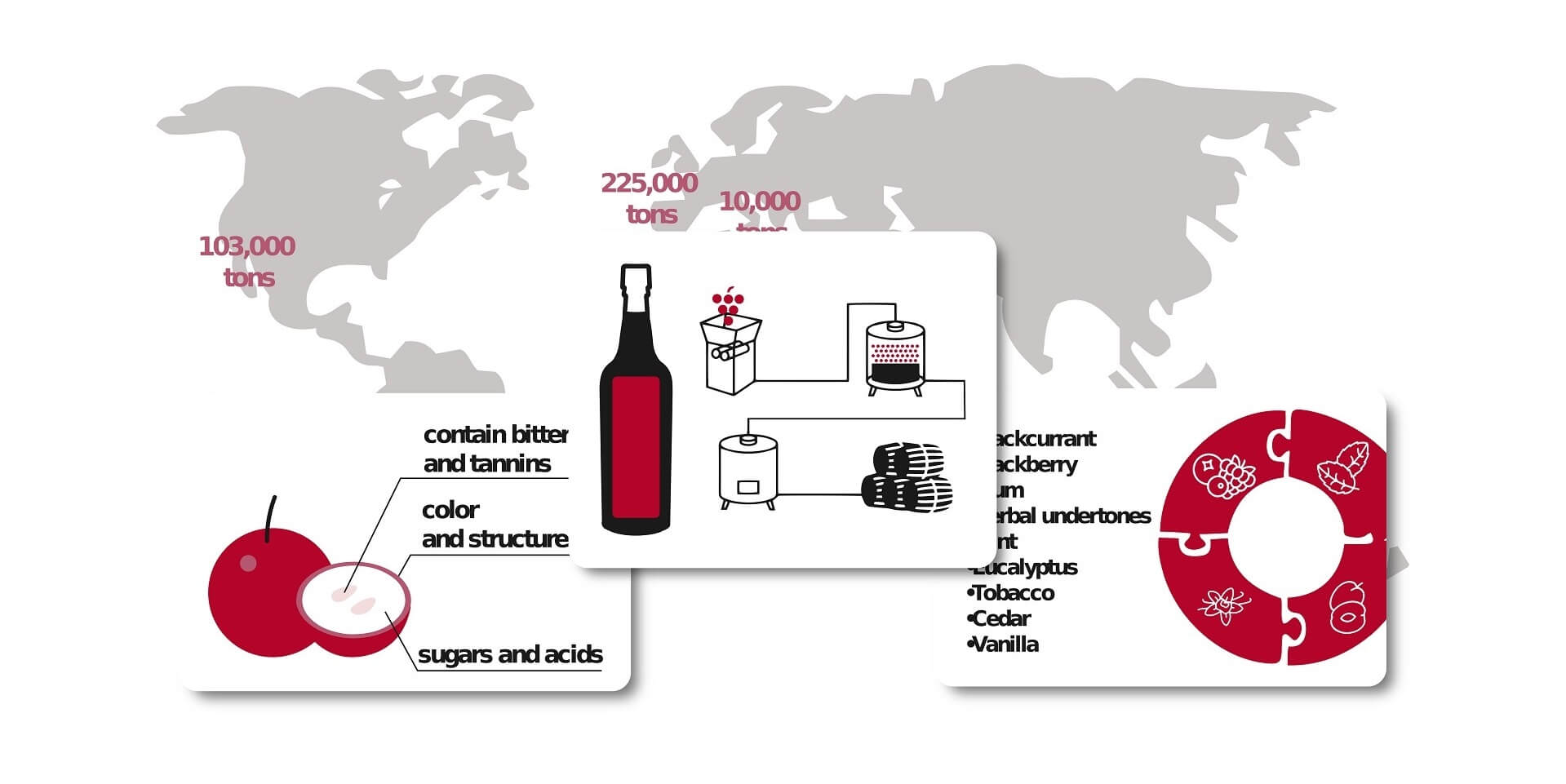
Introduction to Cabernet Sauvignon
Cabernet Sauvignon, often referred to as the "King of Red Wines," is one of the most renowned and widely recognized grape varietals in the wine world. Its deep color, rich flavors, and ability to age gracefully make it a favorite among wine enthusiasts and collectors. In this comprehensive guide, we will explore Cabernet Sauvignon in-depth, focusing on its origins, flavor profile, and its prominent wine regions across the globe.
The Origins and History of Cabernet Sauvignon
Cabernet Sauvignon’s age is what makes it so unique; it can be traced to antiquity. Personally, it is thought to be a natural crossing of Cabernet Franc and Sauvignon Blanc grape varieties hence the name "Cabernet Sauvignon". The variety originated from Bordeaux Region in France and has defied odds to become a global icon. Its adaptability, resilience, and uniformity in quality of taste gave rise to its extensive domestication in varied wine-growing sites.
Cabernet Sauvignon has its own unique flavour profile
Cabernet Sauvignon wines are often iconic for these rich and deep flavors. Usually, they exhibit flavors of dark fruit like blackcurrants, blackberries, and plum that are accompanied by herbl ones, mint, and eucalyptus. And as you go along, you’ll probably spot notes of tobacco, cedar, and vanilla, as you’ve probably guessed, they are also drawn out from the oak aging. Cabernet Sauvignon tannin is not only firm but also providing the whole wine structure and aging potential.
The phenomena of Cabernet Sauvignon’s Boom
This varietal's notoriety is remarkable, and it is cultivated almost everywhere the best wines come from. From vineyards of Bordeaux that have a historical touch to the sun drenched hills of California which have been so nice to offer the perfect taste for Chardonnay, winemakers have recognized this grape for its consistency and how it can showcase the particular terroir of a region.

Part 2: Understanding the Cabernet Sauvignon Grape Varietal
As to really love Cabernet Sauvignon, you need to be able to examine the grape also. In this article, we will be touching on the growing issues in regards to the anatomy of Cabernet Sauvignon and the elements that lead to its successful farming.
The Anatomy of Cabernet Sauvignon Grape
The Cabernet Sauvignon grapes are tiny, scarcely medium-sized, and completely black. They hold the tannins and pigments which work to intensify the wine's color and structure. Fluvium fructus within the grape is juicy which gives an inner sugar and acids for the subsequent fermentation. Besides, grape seeds out of Cabernet Sauvignon grape are also used in winemaking, they have bitter substances and tannins that can influence the end taste of a wine.
Ideal Climate and Terroir for Cabernet Sauvignon
Cabernet Sauvignon loves a climate with lots of sun rays and enough heat and sunshine during growing season. The vineyard gets ideal and comprises light, moderate temperatures, and long, gradual ripening period. The climatic conditions are perfect for the flavors to reach fullness. By Bordeaux which looks to its maritime climate one will definitely grasp the right micro conditions where grown Cabernet Sauvignon. For example, like a warm Napa Valley or Coonawarra, the days are quite warm and nights are cooler increase the grapes' complexity and balance its acidity respectively.
Significant Sub-Varieties and Clones of the Red Cabernet Sauvignon
Historically, Cabernet Sauvignon is a single plant variety, but there are recognisable subvarieties and clones that show unique personality traits. For example, Cabernet Sauvignon, Cabernet Franc and Merlot are strongly linked and can be used for Bordeaux style wine blends. Besides that, winemakers can utilize certain clones of Cabernet Sauvignon that enrich the body or flavor intensity of wine or increase their resistance to diseases. After that in Part 3 we'll enter a realm where we will be exploring the main Cabernet regions from all over the world.
Part 3: The prominent Cabernet Sauvignon Wine Territories
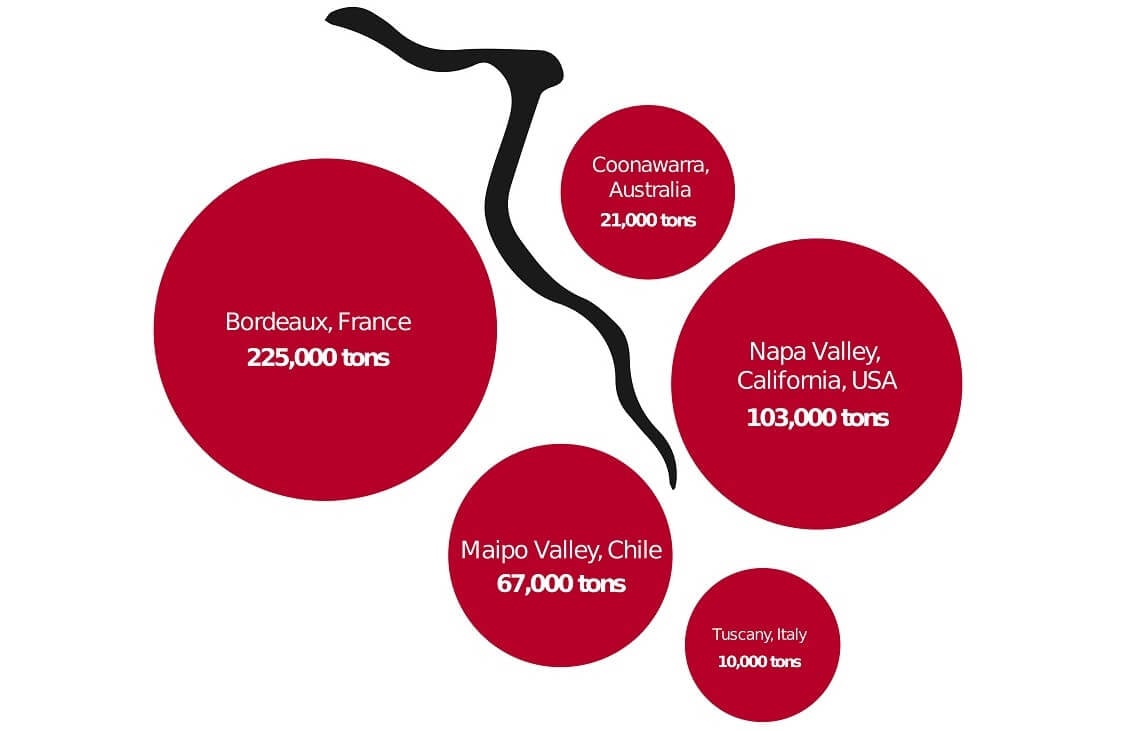
Cabernet Sauvignon is farmed in the most prominent wine-making areas of the world, each adding some distinctive traits to the final wine. We will look at the main Cabernet Sauvignon wine regions in this part of our article and their respective annual production volumes.
Bordeaux, France
Bordeaux, France, is founded on the reputation of ‘Cabernet Sauvignon,’ and enjoys the best-known viticultural region. It has gained wide popularity for its Bordeaux style blends, with Cabernet Sauvignon typically being blended with Merlot, Cabernet Franc, as well as other varieties of grapes. Supplying approximately 225,000 tons of Cabernet to the world every year, Bordeaux is a top-ranking member of the Cabernet Sauvignon club.
Napa Valley, California, USA
Cabernet Sauvignon wines coming from Napa Valley is equivalent to the ravishing quality. The area’s warm climate and a wide range of terrains create courageous, best evolved and harmonious Cabernet Sauvignon wines. Every year, Napa Valley records around a hundred and thirty thousand tons of Cabernet Sauvignon output, proving that it is among the best Cabernet Sauvignon producers in the US.
Coonawarra, Australia
Coonawarra, a South Australian winery, has achieved the status of being famous for the production of refined and age-worthy Cabernet Sauvignon wines. The area terroir consists of one type of soil called terra rossa, which gives the grapes a particular personality. Coonawarra in particular provides 21,000 tons of the good old Cabernet Sauvignon to the global Cabernet production.
Maipo Valley, Chile
Chile's Maipo Valley is world-famous and rightly so for its great cabernet sauvignon products. The commonly experienced in Mediterranean areas climate and the well-drained soils produce the wines with rich fruit aromas and well-structured tannins. The annual output of the Cabernet Sauvignon grape from Maipo Valley amounts to 67 thousand tons. This is a windfall to the global Cabernet Sauvignon market.
Tuscany, Italy
Tuscany, beloved for its native wines made of Sangiovese variety, tends to blend these wines with Cabernet Sauvignon in Super-Tuscan blends. In such cases the Cabernet Sauvignon is usually paired with indigenous grape varieties to give origin to both assertive and unique wines. Tuscany's Cabernet Sauvignon production is smaller, around 10,000 tons per year, but it still matters tremendously for the Italian wine market. In the segment 4, we will look at the ways how winemaking techniques contribute to the nuances of Cabernet Sauvignon wine.
Part 4: The Techniques of Making the Cabernet Sauvignon Wine
The winemaking procedure indisputably steers the traits and different qualities of Cabernet Sauvignon wines as they mature. In this part of the article, we will discuss, in detail, the wine-making techniques that have a tremendous impact on the taste, structure and the aging potential of these wines.
Harvesting and Sorting Grapes
The Cabernet Sauvignon grapes should be gathered at the perfect ripening stage, which is essential for the sake of the quality of wines. These indicators along with the sugar level, acidity and phenolic ripeness have summarily generated the fact that winemakers take all these characteristics into consideration before the vines are cut off. After being harvested, grapes pass through a sorting step to take away all the defect or under ripe ones in order just to make sure the highest quality fruit will be produce the wine.
The Fermentation Techniques for Cabernet Sauvignon
The Cabernet Sauvignon grapes are popular for their thick skins and high tannin content. Thus, the unique fermentation process is significant to leverage the taste. A number of winemakers are nowadays employing long maceration, a process where the juice and skins of grapes stay together longer in order to extract all the sought-after pigments, tannins, and flavors. Moreover, it is usual to be dried in wooden barrels what also ensures the complexity of the wine.
Oak Barrel Aging and the Development of Flavors and Aromas
Aging under oak is widely used for many Cabernet Sauvignon wines. The wine undergoes the ageing process in oak barrels, which gives it the tasting notes of vanilla, cedar, and spice. The type of oak whether it is from France or America will have an impact on the end wine taste. Long aging of oak not only helps in making softer tannins, but also adds complexity of taste in the wine.
Blending with Other Varietals
While Cabernet Sauvignon is mostly known on the market as a single varietal, it is often combined with other grape varieties to create wide range of wine styles. Merlot and Cabernet Franc along with Petit Verdot, mentioned earlier, in Bordeaux blends. Such blends are found to be an excellent combination of all fruit, structure, and complexity as well.
Sustainable Winemaking Practices
The awareness of sustainability in wine production touches on more and more winemakers who settle on environment-friendly practices. The eco-friendly vineyard management and organic farming models which help to keep the vines and the environment healthy for long-term are being popularized. In Part 5, we are going to explore the skill of how you taste and assess Cabernet Sauvignon wines.
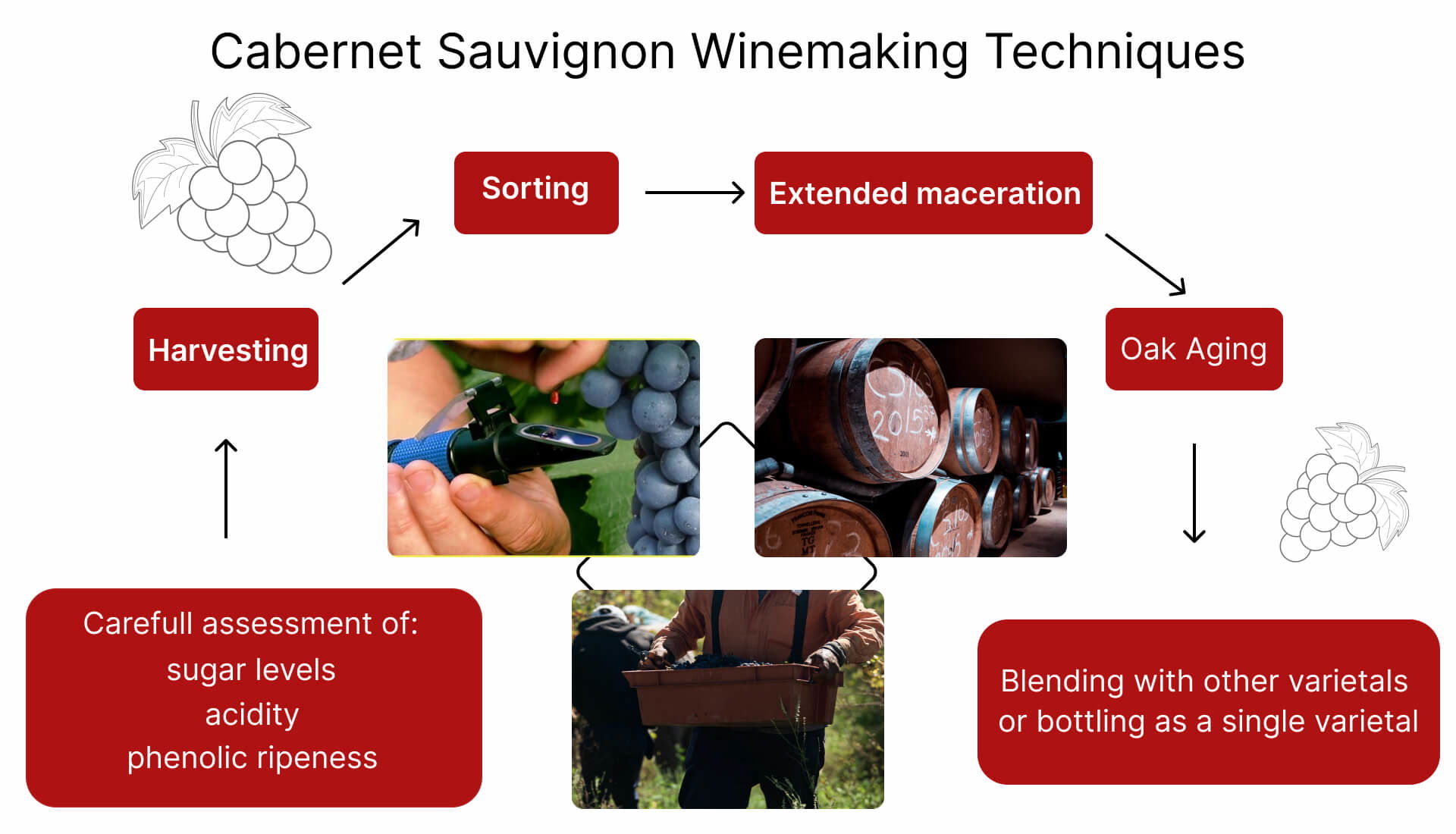
Part 5: Tasting and Analyzing Cabernet Sauvignon
Discerning the aroma and flavor of the Cabernet Sauvignon wine is an art to appreciate the variety of this grape at maximum. In this part, we begin by learning the appropriate ways of tasting and assessing Cabernet Sauvignon wines, including common taste descriptions and the crucial role of wine ratings.
Proper Wine Tasting Techniques
To fully experience the flavors and aromas of Cabernet Sauvignon, follow these essential wine tasting steps:
- Look: Look at the wine’s color and clarity. The primary color range for Cabernet Sauvignon is deep ruby to purple.
- Swirl: Softly swish the wine within the glass to release the scent.
- Smell: Take a moment to smell the wine's aroma. Think about the fruit, herbal, and forest-like smells you smell.
- Sip: Have a small sip and let it overcoat your palate. The wine's texture, acidity, and tannins should also be considered.
- Savor: Let out slowly to see the finish and feel the impression of the wine after all.
Generic Taster Notes for Cabernet Sauvignon
The Cabernet Sauvignon wines preclude a wide variety of flavors they depend on region and winemaking technology.Common flavor descriptors include:
- Blackcurrant: A defining characteristic of Cabernet Sauvignon, which is frequently referred to as cassis.
- Blackberry: The fruitiness and jammy flavors of blackberries are frequently dominant in a myriad of expressions.
- Mint: Mint and eucalyptus are the most widely used plant notes in Cabernet Sauvignon made in cool climates.
- Cedar: Cedar and tobacco notes are produced due to oak aging.
- Vanilla: From the oak barrels come vanilla flavors with complexity.
How to Decode Wine Ratings and Scoring System
Ratings and scores for Cabernet Sauvignon enable to quickly decide optimal quality and distinguishing features. Wine critics and publications which are influential give scores following assessments and blind tastings. Better scores usually mean better wines. On the other hand, wine appreciation is largely decided by individual tastes, however, try different types of wines until you realize the ones that suit you well. In Part 6, we will focus how matching a fine glass of Cabernet Sauvignon with food can make a dining experience amazing.
Part 6: Food matching with the Cabernet Sauvignon

The “bold flavors” and “structured tannins” of Cabernet Sauvignon make it an ideal beverage to pair with food. In this section, we will discuss classical and creative food combos that match the natural features of the Cabernet grape wines.
Traditional Cordial Accompaniments of Red Meat and Game
Cabernet Sauvignon is a perfect wine for red meat dishes with its strong fruity taste and the solidity of tannins. Grilled steaks, roast lamb, and beef stews are perfect examples of classics that highlight the full-bodied, profound nature of the wine. Venison, duck and other game meats are the best match of this solid red.
Vegetarian and Cheese Pairings
Although Cabernet Sauvignon is generally used for meat and protein dishes, it can be equally complementary to vegetarian dishes. Mushroom dishes including mushroom risotto or portobello burgers lend earthy flavors to the wine's herbal notes. Cabernet Sauvignon is an excellent option for aged cheeses like cheddar, gouda, or pecorino because tannins in the wine help to balance the cheese richness.
Think over the Wine's Age and Oak Influence
Along with age, the level of oak in Cabernet Sauvignon is decisive when it comes to food pairings. More often than not younger and fruitier Cabernets will easily harmonize even with a great number of dishes. When its flavor become more complex with age the Cabernet Sauvignon wine can make the more full-bodied and decadent dishes more upgraded.
The Influence of Local Features
As Cabernet Sauvignon wines from different areas have various traits which determine the type of foods to be paired with. Furthermore, Bordeaux-like Cabernet Sauvignon blends with Merlot and Cabernet Franc go well with classic French food, while Napa Valley Cabernets match with American-style barbecued meat.
Introducing Cabernet Sauvignon to be congruent with the menu
Feel free to experiment and innovate with Cabernet Sauvignon pairings. If you put it with the dark chocolate desserts, you will offer a wonderful play of tastes as well. In addition, spicy and strong dishes with distinctive flavors can make an attractive taste experience when a good Cabernet Sauvignon matches them. Keep in mind that the choice of wine pairing is a personal issue: thus, experiment and discover what you enjoy most. In Part 7 we will discuss about aging and maturation of Cabernet Sauvignon wines through cellaring that can lead to increased complexity and maturity.
Part 7: Cabernet Sauvignon Aging and Cellaring
Cabernet Sauvignon was born to age, and a good cellaring process will convert a good wine into a truly great one. As part of this section, we will cover Cabernet Sauvignon wine and aging process, and factors that should be taken under advisement when cellaring them.
Aging Cabernet Sauvignon: Best Practices
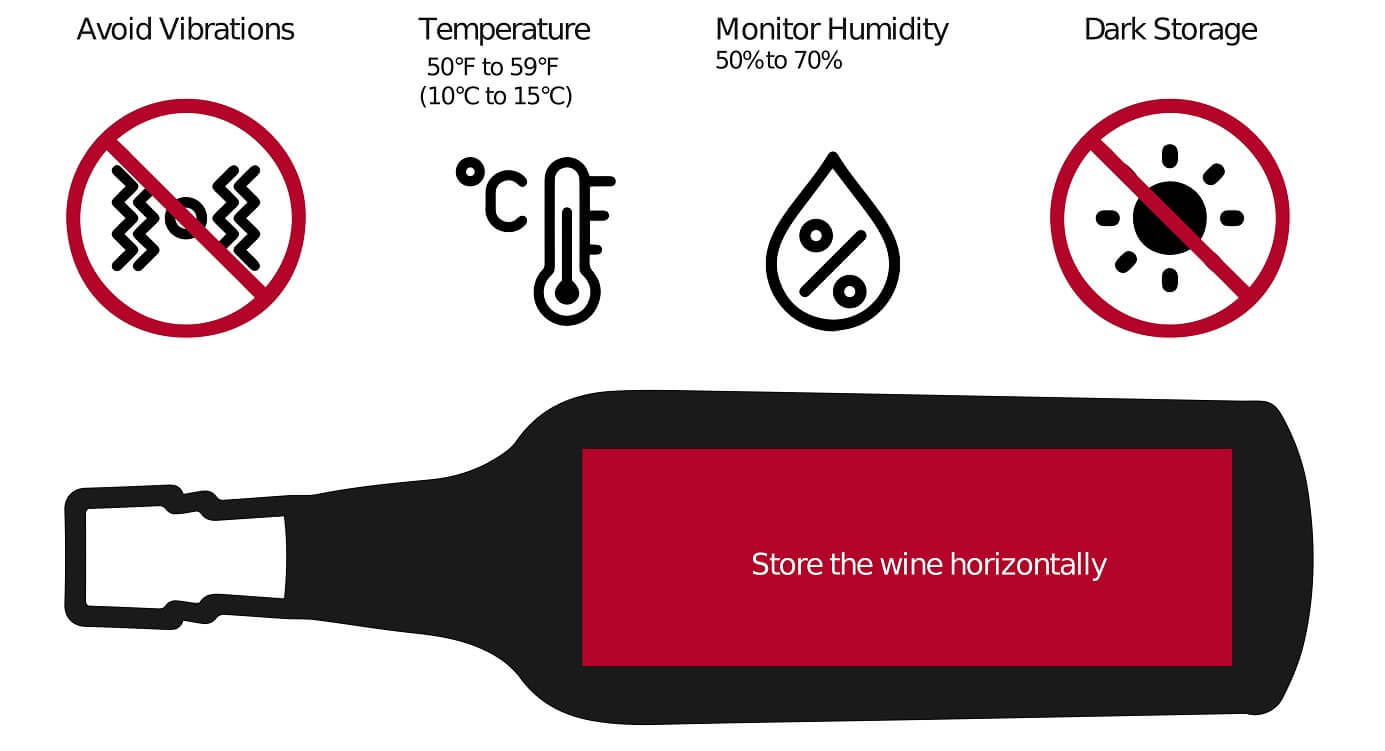
Aging Cabernet Sauvignon can soften its tannins, integrate flavors, and develop complex tertiary aromas. Here are some best practices for aging this noble grape:
- Choose High-Quality Wines: Choose wines from well-known producers and favourable vintages for storage.
- Optimal Storage Conditions: Keep the wine horizontally in a cool, dark, and humid storage area in order to discourage cork drying and extreme temperature variations.
- Temperature: Shoot for a constant temperature in the range of 50°F to 59°F (10°C to 15°C) instead, to enable slow and mature aging process.
- Avoid Vibrations: It is better to keep the wine far from sources of vibration, for such means can spoil the wines in aging.
- Monitor Humidity: Keep the humidity between 50%-70% in order to stop corks from drying and affecting the wine's quality.
- Dark Storage: Shield the wine from direct sunlight as UV rays can damage the wine and give birth to irrelevant flavors.
Perfect Aging Timeline of Cabernet Sauvignon
The ideal aging timeline of the Cabernet Sauvignon will depend on style, region, and the vintage of the tradition. General guideline:
- Young Wines: 1 to 3 years - Treat yourself to the freshness and youth of the new world wine.
- Middle Age: 5 to 10 years - See how tertiary flavors are noticeably evolving with more obvious harmony.
- Maturity: 10 to 20 years - Feel the main expression of the wine with all its richness and height.
- Older Vintages: 20+ years - Sit back, relax and dissect the tones of a perfectly matured Cabernet Sauvignon and its grandiose structure.
Cellaring and keeping the collectible Cabernet Sauvignon
Wine conservationists will find the process of ageing Cabernet Sauvignon to be very fulfilling. Keep abreast of the wines in your collection by writing down the dates when they are bought, the vintages, and the best time to drink them. Preferably, do regular tasting to monitor the wine’s change and to find the best drinking moments.
Decanting Older Cabernet Sauvignon
When you open a bottle of Cabernet Sauvignon that has already spent a significant time in the bottle, you might benefit from decanting the wine. This will separate it from any sediment that could have accumulated. Another appealing feature of decanting is that it allows the wine to breathe and develop, which in turn makes it more flavorful and aromatic. In Part 8, we will cover neck-bending Cabernet Sauvignon choices at an unbeatable price while maintaining its integrity.
Part 8: Simple and cheap Cabernet Sauvignon choices
Despite the growing cost of high-quality Cabernet Sauvignon wines, it does not have to be a burden. This chapter features a few inexpensive Cabernet Sauvignons that offer decent taste and character without breaking down your wallet. These wines are easy-drinking and very suitable for your every day occasion.
1. Bread & Butter Cabernet Sauvignon 2022
2. Chateau Purcari Negru de Purcari 2021
3. Clos de Gat Har'el Cabernet Sauvignon 2019
4. Montes Alpha Special Cuvee Cabernet Sauvignon 2021
5. 689 Cellars Submission Cabernet Sauvignon 2020
These budget-friendly Cabernet Sauvignon wines provide an amazing selection of complexity and taste for such a low price. Whether you are having a casual dinner or just relaxing after a hard day, these wines are perfect for any occasion. In Part 9, we will address new Cabernet Sauvignon regions that have stirred much appreciation and commendation among world wine connoisseurs.
Part 9: Developing young Cabernet Sauvignon wine regions
Although established wine regions, including Bordeaux and Napa Valley, are synonymous with the Cabernet Sauvignon grape type, some newer regions are also emerging fast to become known for their outstanding versions of this noble variety. In this area, we shall delve a bit deeper into these exciting the wine regions that are indeed making a mark in the Cabernet Sauvignon world.
1. Washington
Unlike California, Washington has a cooler climate and an element of making a Cabernet Sauvignon that is slightly elegant. On the nose you'll get a bouquet of dark plum, blackberry and tons of spice. Washington wines are full-bodied and softened by the tannins.
2. Barossa Valley
The Barossa Valley is the most renowned Australian wine region for the production of different wines from the red grape varieties. Cabernet Sauvignon from the region shows strong notes of licorice, bitter chocolate, red berries, and a little of smoke. Due to the fact that of the heavy dark clay in the soil the wines usually have the specific earthy flavor.
3. Margaret River
The Western Australia has more of a cold and maritime climate. This results in the Bordeaux region being the most famous and distinguished for full-bodied Cabernet Sauvignon used for the best red wines. Tastes of Margaret River wines are deep and fruity.
4. Mendoza
Argentina produces good quality wines for all the budgets. Cabernet Sauvignon wines in Mendoza are strong and lush due to the blazing hot and dry summers and the grape irrigation.
5. Israel
This land is bearing a reputation of its long-term viticulture and has now a resurgence. Israeli Cab thrives in chilly and higher slopes and is of a complex gene type.
Such new regions are now making Cabernet Sauvignon wines which are getting comments from wine buffs. Discovering these out of the way regions may be a lovely trip of discovery and appreciation of how diverse Cabernet Sauvignon wines can be. In the section 10, we will present to you some useful Cabernet Sauvignon purchasing tips and decipher confusing wine labels to help you make most informed decisions.
Part 10: Instructions for buying Cabernet Sauvignon
Buying Cabernet Sauvignon can be a fun activity, but with so many options to choose from, knowledge becomes power. In this part, we will offer useful tips on how to make the right choice of Cabernet Sauvignon wines that suit your palate.
Reading the Wine Labels and Determining the Appellations
Wine labels provide cues with respect to the vineyard from which the Cabernet Sauvignon is being produced. Look for the following key details:
- Appellation: The origin of wine is toral for the recognition of its style and quality. Search for designated areas by name like Bordeaux, Napa Valley or Coonawarra.
- Vintage: The year of vintage can greatly affect the main qualities of the wine. Think about the wine's age and the influence that weather had on it during that year.
- Producer: Reasonable brands usually create wine in a consistent manner that is also of a high quality. Get acquainted with credible vineyards and their unique styles.
- Alcohol Content: The alcohol by volume (ABV) percent can offer some guidance to wine's richness and body. As ABV increases, wines can become more aggressive and above-average in profile.
- Designations: Some wines may bear other titles as well, such as "Reserve" or "Grand Cru," signifying certain quality or aging.
Recognizing Value and Quality
For the Cabernet Sauvignon wine evaluation, the pricing to quality must be taken into account. Although not all premium wines are a ravishing taste, we should not forget that there are also lots of value wines that provide us with high-quality taste at lower prices. Wines that suit your taste preferences and budget are the best.
Seek Expert Recommendations
Do not hesitate to ask for advice from wine gurus, sommeliers or your favorite wine shop specialist. They can give you valuable recommendations for some Cabernet Sauvignon varieties that perfectly fit your style.
Attend Tastings and Events
Cabernet Sauvignon tasting events and wine tastings at nearby wine stores are open to participants to try different types of this wine variety. Such activities can make you more discerning about your palate and find out new favorites.
Join Wine Clubs
Think about subscribing to a wine club with the focus on Cabernet Sauvignon. Being part of a wine club usually means that you will be provided with professionally selected wines and limited editions, which will give you an opportunity to enjoy different vintages. By applying this advice, one can navigate yourself around the globe of Cabernet Sauvignon with the confidence of making measured selections that meet your palate and taste. In part 11, we will try to answer often asked questions about Cabernet Sauvignon to give the audience more information and understanding.
FAQs about Cabernet Sauvignon
The Cabernet Sauvignon, which is a famous and multi-functional wine, is often a subject to inquiries from wine lovers. In this part of the article we deal with some of the most frequently asked questions to present more detailed information on this very popular grape variety.
-
Which foods go best with Cabernet Sauvignon?
Answer: The Cabernet Sauvignon variety goes very well with red meat dishes, like grilled steaks, roast lamb or beef stews. It, furthermore, can be served as an appetizer or alongside hearty meals such as game meats and aged cheeses. If you are looking for a unique experience, then, don’t forget to try it with dark chocolate.
-
How many years should I age Cabernet Sauvignon wines?
Answer: Cabernet Sauvignon wine possesses an outstanding aging capacity, some of its premium vintages can taste pleasant and mellow even after 20 years. The aging timeline of each wine varies depending on the style, the region and the vintage. The younger cabernets can be consumed for 1 to 3 years, whereas the top quality ones will mature and improve for 10 to 20 years and more.
-
What is the best way to keep Cabernet Sauvignon for ageing?
Answer: Adequate storage is the key factor for aging mature Cabernet Sauvignon wines. Keep the wine lying horizontally in a cool, dark, and humid surroundings, with a temperature at around 50°F to 59°F (10°C to 15°C). Beware of vibration sources and exclude wine from the direct light.
-
Do you have any budget-friendly Cabernet Sauvignon alternatives?
Answer: It is right that there many affordable Cabernet Sauvignon wines that have good quality but at relatively low price. See if there are wines from new regions or even those coming from reputable growers that offer good-quality wines for decent prices.
-
Which regions now make Cabernet Sauvignon?
Answer: Among the new-comer regions that have become legendary for crafting fantastic Cabernet Sauvignon wines are Washington, Barossa Valley, Margaret River, Mendoza, and Israel. This is another reason why these areas have begun to gain importance, especially their unique terroir and how it gives their wines a particular Cabernet Sauvignon character.
These FAQs provide with a great insight into the main aspects of Cabernet-Sauvignon, therefore you will have an opportunity to enjoy and appreciate this grape through knowledge. Ultimately, cabernet sauvignon's versatility, its different flavors, and its aptitude to age make it a noteworthy option for wine lovers all over the globe. Whether you are drinking a young Cabernet Sauvignon that is fruitful and fresh, or a mature nicely aged vintage, there is an incredible taste with every sip. If you would to go and make your purchase some of the best Cabernet Sauvignon vintages ever, you can visit 8wines.com to get their all-inclusive range of premium wines from across the world. Bravo to the enjoyment of the exploration of the world of Cabernet Sauvignon!







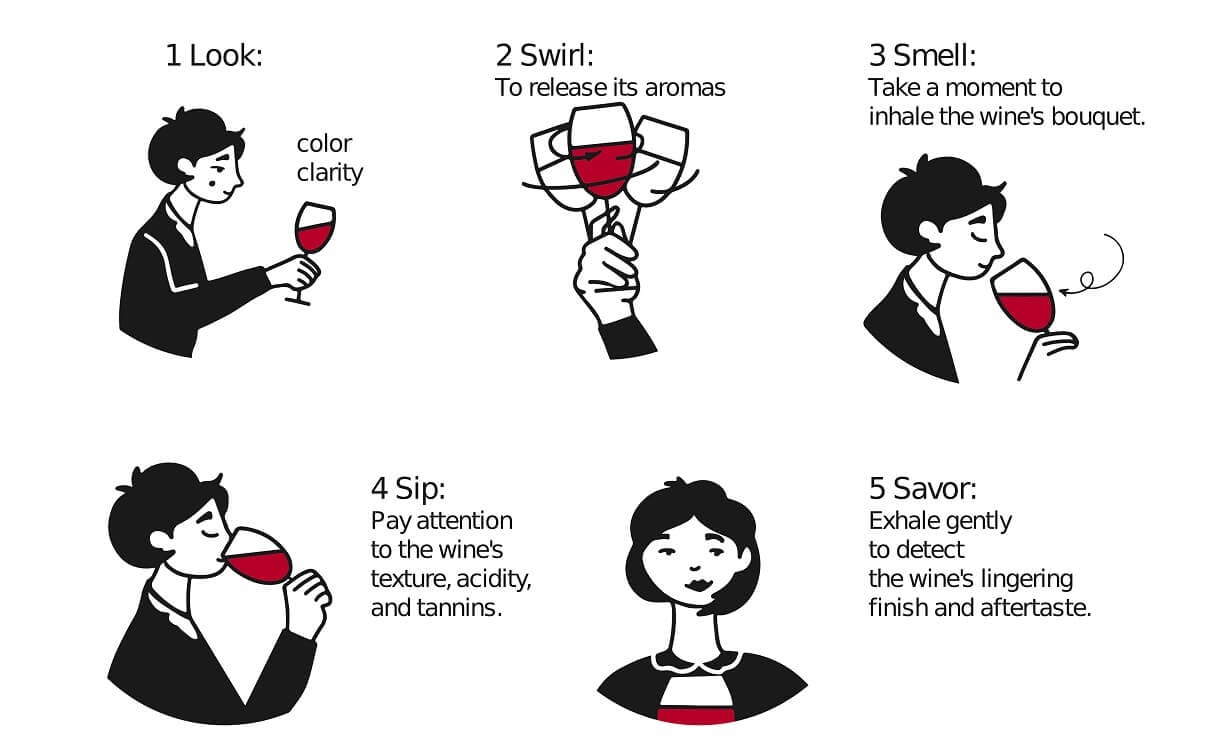
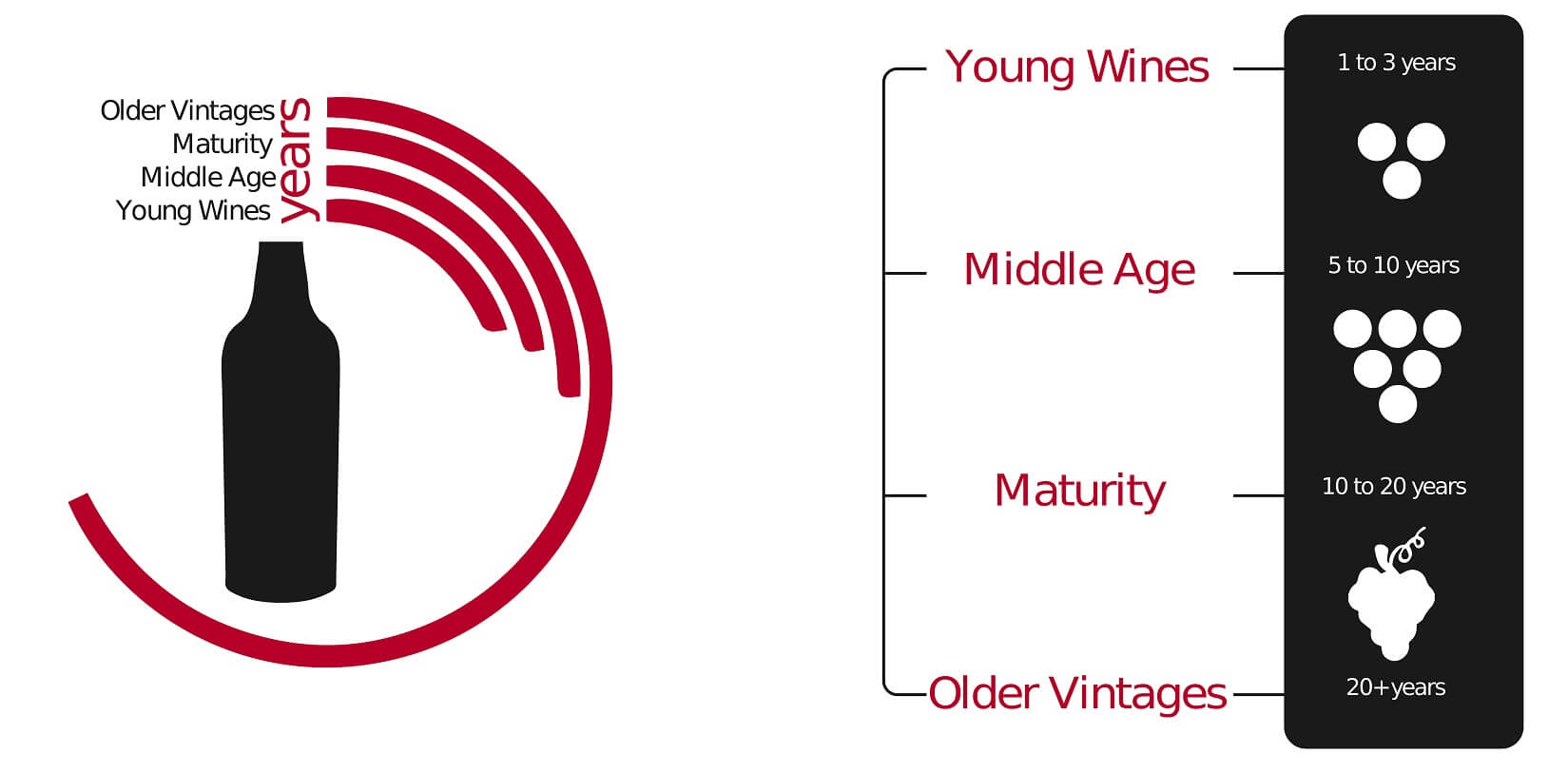



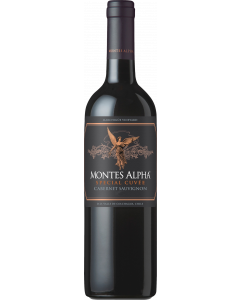

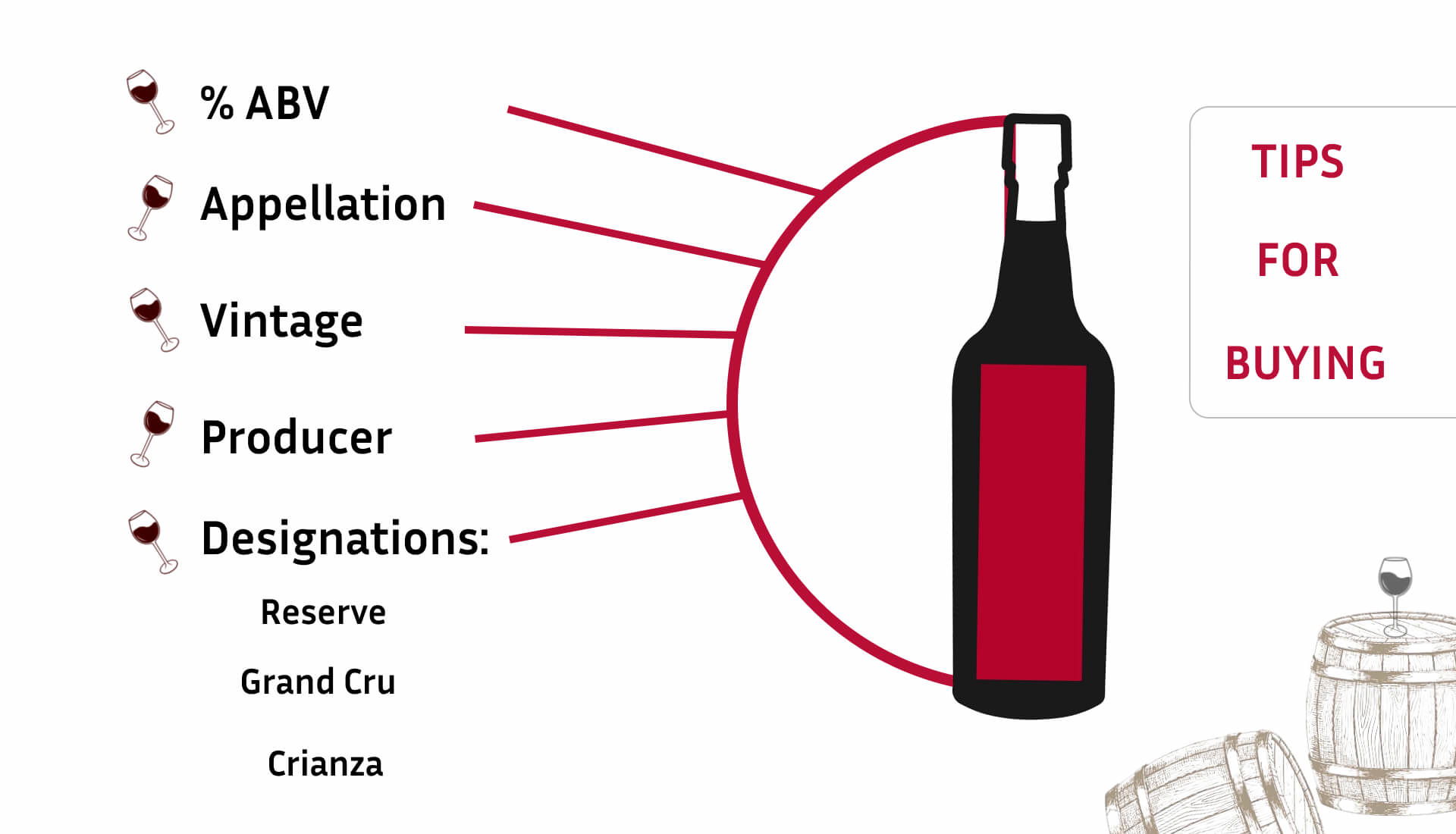



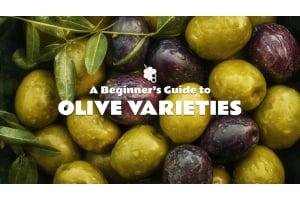
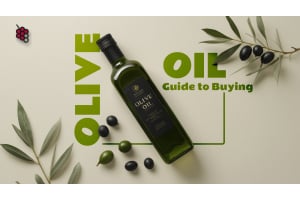

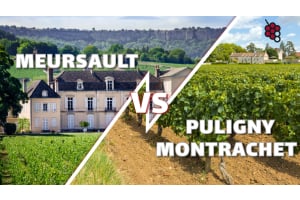


I like the selection of nice wines a lot. What could be better is taking good care of the wines during transport. It is very cold in Holland and the wines i received yesterday where freezing cold. I hope that they are not damaged by the cold.